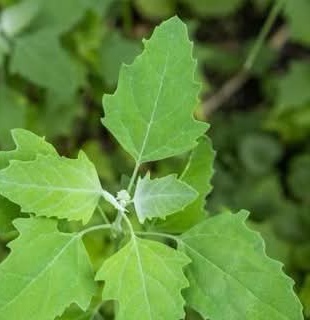Ingredients
Amidst the plethora of edible plants, Lamb’s Quarters (Chenopodium album) stands out as a nutrient-dense powerhouse often dismissed as a common weed. Known by various names, including Wild Spinach, Goosefoot, and Fat Hen, this resilient green thrives in diverse environments, from backyard gardens to roadsides. Despite being overshadowed by more mainstream greens like kale and spinach, Lamb’s Quarters boasts an impressive nutritional profile that warrants a place on our plates.
Nutritional Profile: A Treasure Trove of Vitamins and Minerals
Lamb’s Quarters is packed with essential nutrients, making it a valuable addition to a healthy diet:
Rich in Vitamins – It contains high levels of vitamin A (essential for eye health and immunity), vitamin C (a potent antioxidant), and vitamin K (important for blood clotting and bone health).
Mineral-Dense – This leafy green provides significant amounts of calcium, iron, magnesium, and potassium, all vital for bone strength, muscle function, and overall well-being.
Protein and Fiber – Unlike many leafy greens, Lamb’s Quarters is relatively high in protein, making it an excellent plant-based source. Its fiber content supports digestive health and promotes satiety.
Antioxidants and Omega-3s – The plant contains flavonoids and polyphenols with anti-inflammatory properties, as well as small amounts of omega-3 fatty acids beneficial for heart health.
Health Benefits: More Than Just a Weed
- Supports Digestive Health – The fiber in Lamb’s Quarters promotes gut health, aiding digestion and preventing constipation.
- Boosts Immunity – Its high vitamin C and antioxidant content strengthen the immune system and combat oxidative stress.
- Enhances Bone and Blood Health – With abundant calcium, magnesium, and vitamin K, it supports strong bones and proper blood clotting.
- Aids in Detoxification – Traditionally used as a cleansing herb, it helps the body eliminate toxins naturally.
- May Help Manage Inflammation – The antioxidants in Lamb’s Quarters contribute to reducing inflammation, which is linked to various chronic diseases.
Culinary Uses: A Versatile and Delicious Green
Lamb’s Quarters has a mild, slightly nutty taste similar to spinach. It can be enjoyed in numerous ways:
- Raw in Salads – Young leaves add a nutrient boost to fresh salads.
- Sautéed or Stir-Fried – Cooked like spinach, it pairs well with garlic and olive oil.
- Added to Soups and Stews – A great addition to broths, lending both flavor and nutrition.
- Blended in Smoothies – When mixed with fruits and other greens, it creates a supercharged drink.
- Used in Baking – The seeds can be ground into flour and incorporated into bread or crackers.
Foraging and Precautions
Lamb’s Quarters is widely available in the wild, but foragers should be cautious:
- Avoid Contaminated Areas – Ensure plants are not growing in polluted soil or sprayed with pesticides.
- Oxalate Content – Like spinach, it contains oxalates, which can interfere with calcium absorption. Cooking reduces oxalate levels significantly.
- Moderation is Key – While highly nutritious, excessive consumption may contribute to kidney stone formation in susceptible individuals.
Conclusion: A Green Worth Celebrating
Lamb’s Quarters is a nutritional powerhouse hidden in plain sight. Once regarded as a mere weed, it deserves recognition as an affordable, accessible, and health-boosting green. Whether foraged or cultivated, incorporating this wild spinach into your diet can provide an array of health benefits while connecting you to nature’s forgotten superfoods.
Would you consider adding Lamb’s Quarters to your meals? Let us know how you’d prepare this overlooked gem
